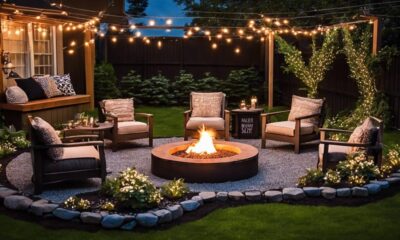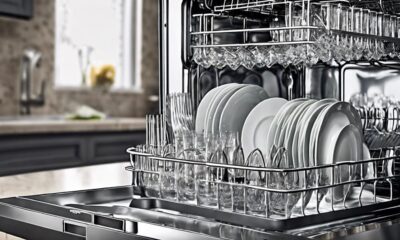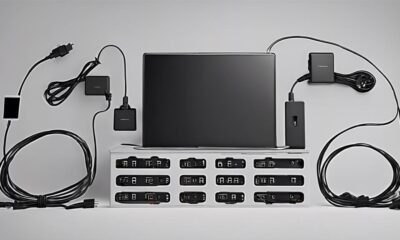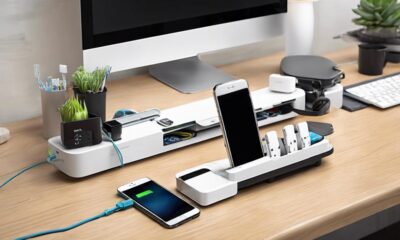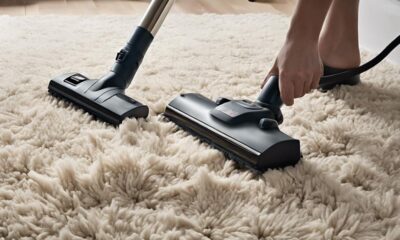Decor
How to Create Your Own DIY Coffee Bar in 5 Easy Steps
Yearning to create a cozy coffee nook at home?

To create your own DIY coffee bar in five simple steps, begin by carefully measuring your space with a measuring tape. Allocate distinct zones for equipment like espresso machines and grinders. Emphasize functionality by using bar mats and cleaning tools regularly. Personalize your setup with coffee-themed decor and warm lighting. Organize strategically by arranging supplies in visually appealing displays. These steps guarantee functionality and aesthetics.
Key Takeaways
- Measure space accurately for shelves and equipment.
- Allocate specific zones for espresso machine, grinder, and accessories.
- Emphasize cleanliness with tools like bar mats and puck screens.
- Personalize with coffee-themed decor elements for ambiance.
- Organize supplies strategically for easy access and visual appeal.
Measure Your Space
Let's begin by measuring the available space for our DIY coffee bar setup. Using a measuring tape, we can accurately assess the dimensions needed for our coffee bar.
It's important to make sure that the space we allocate can comfortably accommodate our coffee maker, grinder, and other accessories. Consider the height and width of shelves or storage units to organize our coffee supplies efficiently.
Precision in measuring the space will play a key role in designing a functional and visually appealing coffee bar that seamlessly fits into our home.
Allocate Equipment Zones

Now that we've measured our space for the DIY coffee bar, it's time to strategically allocate equipment zones to optimize our coffee-making setup.
Dividing the coffee bar into specific zones for the espresso machine, grinder, milk frother, and accessories like spoons, cups, and syrups is essential for a well-organized workspace. By designating separate areas for each equipment, we can streamline the workflow, guaranteeing a smooth and efficient operation. To enhance functionality, it's advisable to create a workflow from left to right, allowing for a logical progression in the coffee-making process.
Customizing the equipment zones based on your preferred brewing methods and personal preferences is key to maximizing the functionality of your coffee bar. This tailored approach ensures that everything you need is within reach, optimizing both the efficiency and enjoyment of your coffee-making experience.
Prioritize Cleanliness

To maintain a hygienic environment at our DIY coffee bar, emphasizing cleanliness is vital. We must create a space that not only brews great coffee but also prioritizes hygiene. Utilizing tools like a bar mat can help catch spills and keep our coffee bar clean, while regularly replacing cleaning brushes ensures that hygiene standards are consistently met.
Employing items such as a puck screen during the brewing process can further guarantee a clean and efficient operation. Focusing on the cleanliness of our espresso machines is essential for peak performance. Specifically, paying attention to maintaining the cleanliness of the espresso machine's group can greatly impact the quality of the coffee produced.
Personalize With Decor

When personalizing your DIY coffee bar with decor, consider incorporating coffee-themed elements to add character and charm to the space. Here are some ideas to help you create a cozy and inviting atmosphere for your coffee bar:
- Wall Art:
Hang coffee-themed wall art, signs, or posters to showcase your love for coffee and add a touch of personality to the space.
- Shelving Units:
Use decorative shelving units to display mugs, plants, or coffee accessories, adding both functionality and visual interest to your coffee bar.
- Chalkboard or Letter Board:
Incorporate a chalkboard or letter board to highlight daily specials, inspirational quotes, or even the menu, providing a customizable and interactive element to your decor.
- Lighting Fixtures:
Enhance the ambiance of your coffee bar with warm lighting fixtures such as string lights or lamps, creating a cozy and inviting atmosphere for your guests to enjoy their coffee.
Organize Strategically
- A clean, clutter-free countertop
- Shelves with neatly arranged mugs and coffee accessories
- Labeled containers for coffee beans and sugar
- A stylish coffee maker and grinder
- Cozy seating area nearby. –v 6 –ar 16:9

Strategically organize your coffee supplies, accessories, and essentials to optimize functionality and efficiency in your DIY coffee bar setup. Arrange items such as coffee beans, filters, and spoons in designated sections for easy access.
Consider using shelves, baskets, or bins to keep smaller items like syrups, cups, and accessories organized and within reach. Creating a visually appealing display with mugs, stir sticks, and other coffee essentials not only enhances the aesthetic of your bar but also makes it easier to locate items quickly.
To further enhance organization, labeling containers or using clear jars can help in identifying and finding items effortlessly. By keeping frequently used items within arm's reach, you can streamline the coffee-making process and make your bar more user-friendly.
Frequently Asked Questions
How to Make Your Own Coffee Bar?
To make your own coffee bar, we recommend the following steps:
- Designate a space in your home.
- Gather tools like a coffee maker and grinder.
- Organize supplies such as coffee beans and filters.
- Personalize your coffee bar with decor.
- Ensure a smooth workflow.
These steps will help create a functional and stylish coffee bar that enhances your home's aesthetic.
With the right setup, you can enjoy a convenient and enjoyable coffee-making experience right at home.
What Ingredients Do I Need for a Coffee Bar?
To create a well-equipped coffee bar, we need a variety of essential ingredients. Ground or whole coffee beans are a must-have for brewing fresh coffee.
Filters are necessary for drip coffee makers to guarantee a smooth cup. A measuring scoop helps accurately portion out coffee grounds. Spoons and stir sticks come in handy for customizing drinks.
Stock up on syrups, flavored creamers, and sweeteners to enhance your coffee creations.
How to Set up a Coffee Bar for a Party?
To establish a coffee bar for a party, designate a specific area for easy access and organization.
Offer various brewing methods like a coffee maker, espresso machine, and French press to cater to different preferences.
Provide syrups, milk alternatives, and sweeteners for customization.
Display a selection of mugs, cups, and stir sticks for guests.
Enhance the experience with pastries or snacks.
This setup guarantees guests can enjoy a personalized coffee experience at the party.
How to Stage a Coffee Bar?
When staging a coffee bar, it's essential to curate an inviting atmosphere. Utilize shelves, trays, and hooks for organized displays of coffee beans, syrups, cups, and accessories. Incorporate warm lighting, comfortable seating, and coffee-themed decor to create a cozy ambiance.
Enhance the setting with artwork, plants, and soft background music. Offer a diverse menu of coffee drinks, snacks, and specials to cater to various preferences and maintain interest among customers.
Conclusion
To sum up, creating your own DIY coffee bar can be a fun and rewarding project. By following these five easy steps, you can transform your space into a personalized coffee haven.
Remember to measure carefully, allocate equipment zones efficiently, prioritize cleanliness, personalize with decor, and organize strategically.
With attention to detail and a touch of creativity, you can enjoy your favorite coffee beverages in the comfort of your own home.
- About the Author
- Latest Posts
Introducing Ron, the home decor aficionado at ByRetreat, whose passion for creating beautiful and inviting spaces is at the heart of his work. With his deep knowledge of home decor and his innate sense of style, Ron brings a wealth of expertise and a keen eye for detail to the ByRetreat team.
Ron’s love for home decor goes beyond aesthetics; he understands that our surroundings play a significant role in our overall well-being and productivity. With this in mind, Ron is dedicated to transforming remote workspaces into havens of comfort, functionality, and beauty.
Southeast Asia Decor
Comparing Feng Shui Tips for Local Furniture Layouts
Feng Shui tips for local furniture layouts can transform your space—discover how small changes can lead to significant improvements in energy flow and harmony.

When comparing Feng Shui tips for local furniture layouts, focus on optimizing the flow of Chi in your spaces. Start by positioning larger furniture against solid walls for stability, and create clear pathways to encourage smooth energy movement. In the living room, arrange seating in a circular formation to enhance conversation and connection. For bedrooms, place the bed against a solid wall to promote restful sleep. Remember, decluttering is essential to avoid blocking energy flow. By following these strategies, you'll transform your home into a tranquil haven that fosters well-being—there's much more to explore on how to achieve this!
Key Takeaways
- Furniture placement should prioritize clear pathways to promote positive Chi flow and enhance overall comfort in living spaces.
- Tailor arrangements to each room's purpose, such as circular seating in living rooms for conversation and strategic bed placement in bedrooms for security.
- Use natural materials and calming colors to create inviting atmospheres and balance Yin and Yang in your decor choices.
- Regularly declutter spaces to prevent stagnant energy and maintain an inviting, harmonious environment throughout the home.
- Avoid overcrowding and misalignment with doorways to ensure smooth energy movement and enhance the welcoming nature of your living spaces.
Understanding Feng Shui Principles
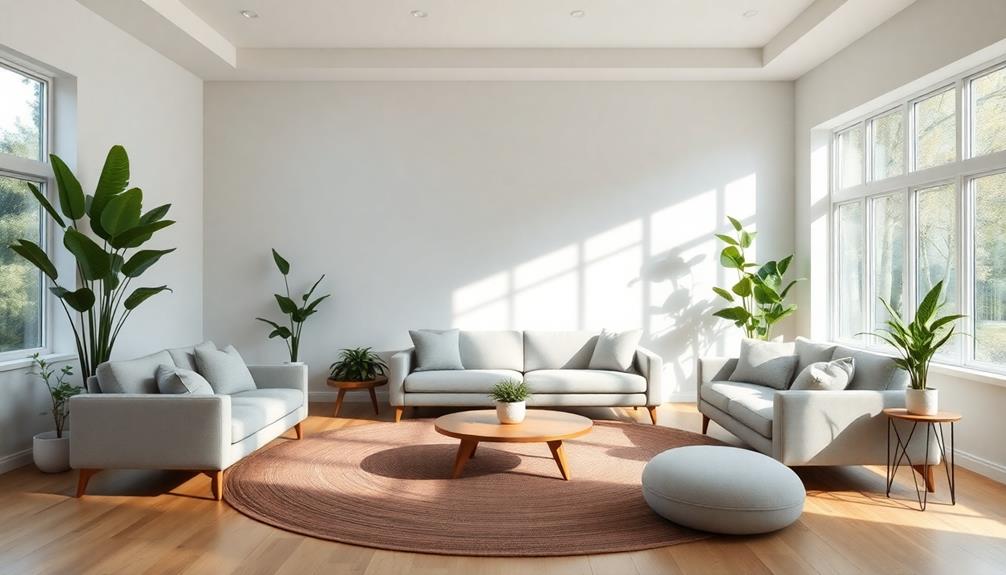
When you plunge into the world of Feng Shui, understanding its core principles is essential for creating a harmonious living space. The flow of energy, or Chi, is central to Feng Shui. You want your home to facilitate this energy's movement, so consider how furniture placement impacts this flow. Blockages can lead to stagnant energy, diminishing the positive energy in your environment.
Incorporating natural materials like wood and stone, as seen in Balinese design elements, can enhance this flow and promote a sense of tranquility.
Balancing Yin and Yang energies is significant, so pay attention to the colors and materials you choose. Warm colors can stimulate energy, while cool tones promote relaxation, making thoughtful selection crucial based on each room's purpose.
The five elements—wood, fire, earth, metal, and water—interact cyclically, promoting balance when arranged harmoniously. However, improper arrangements can create friction.
Decluttering is another key principle of Feng Shui. A tidy space enhances energy movement and clears stagnant sources, leading to a more inviting atmosphere.
Importance of Furniture Placement

When you think about furniture placement, consider how it impacts energy flow and your comfort.
The right arrangement not only enhances functionality but also creates a harmonious atmosphere where movement feels natural.
Incorporating elements of Indonesian traditional decor can further enrich the space, adding character and warmth.
Energy Flow Optimization
Furniture placement plays an essential role in maximizing energy flow within your living space. By thoughtfully arranging your furniture, you can enhance the movement of Chi, allowing positive energy to circulate freely. Incorporating culturally significant decor, such as traditional artistry like Indonesian masks, can further enrich the atmosphere of your home.
Here are some key tips to reflect on for achieving a harmonious living space:
- Avoid aligning furniture directly with doors to prevent obstructing movement.
- Position larger pieces, like sofas, against solid walls for stability.
- Choose appropriately sized furniture to avoid cluttering the space.
- Keep pathways clear to promote smooth energy flow.
- Regularly reassess your layout to maintain ideal energy dynamics.
When you strategically place your furniture, you foster a welcoming atmosphere and create a sense of security. Oversized furniture can block essential energy pathways, leading to stagnation.
Comfort and Functionality
Creating a comfortable and functional living space hinges on thoughtful furniture placement that prioritizes both aesthetics and usability. Proper arrangements enhance comfort by encouraging social interaction, making your home feel more inviting. Here's how you can achieve that balance:
| Key Considerations | Benefits |
|---|---|
| Clear Pathways | Guarantees safety and ease of movement, enhancing energy flow. |
| Proportional Sizing | Prevents cramped spaces and maintains a balanced environment. |
| Thoughtful Placement | Promotes social interaction and connection among inhabitants. |
When arranging furniture, make certain to avoid tripping hazards and awkward positioning. This not only facilitates smooth energy flow but also creates an inviting space for guests. Guarantee that furniture doesn't block doorways or windows, allowing natural light and airflow to circulate freely. Regularly assess your layout; adjusting furniture placement can help maintain the overall functionality and comfort of your living area. By prioritizing these elements, you can create a balanced environment that fosters well-being and connection, enhancing the quality of your home life considerably.
Energy Flow in Different Rooms

Achieving a harmonious energy flow in your home involves thoughtful furniture arrangements tailored to each room's purpose.
For instance, incorporating elements of traditional Indonesian style home decor can enhance the natural ambiance and promote relaxation.
Consider these essential tips for optimizing energy flow:
- Create circular seating in the living room to boost conversation and enhance energy flow.
- Position the bed in the bedroom against a solid wall for a sense of security and restful sleep.
- Place the stove in the kitchen so you can see the entrance, promoting control and positive energy during cooking.
- Use a round table in the dining room to encourage inclusivity and maintain stable energy flow.
- Incorporate natural elements like plants and wood materials to ground the atmosphere.
Living Room Layout Strategies

When arranging your living room, prioritize conversation-focused layouts that encourage connection among family and friends.
Incorporating elements from luxury tropical design aesthetics can enhance the overall ambiance, making the space feel more inviting.
Keeping pathways clear is essential, as it allows for smooth movement and maintains a positive energy flow.
Conversation-Focused Arrangements
A well-designed living room layout can transform your space into a hub of conversation and connection. By focusing on Feng Shui principles, you can enhance the energy flow and create a harmonious space for family and friends.
Incorporating elements of Indonesian wedding decor can also inspire vibrant and inviting arrangements. Here are key strategies for conversation-focused arrangements:
- Arrange sofas and chairs in a circular formation to foster interaction.
- Position seating to face each other, promoting engagement and connection.
- Use area rugs to define conversation groups and enhance intimacy.
- Avoid sharp corners and obstacles to maintain smooth energy flow.
- Incorporate a central focal point, like a coffee table or artwork, to draw attention and encourage conversation.
Pathway Clarity Importance
Clear pathways in your living room layout are crucial for maintaining a positive flow of energy, or Chi. When you prioritize pathway clarity, you facilitate smooth energy flow, allowing Chi to circulate freely and avoiding feelings of congestion or stagnation. Incorporating unique decor, such as a Face Indonesian Decor Mask, can also enhance the aesthetics of your space while promoting cultural appreciation.
If your furniture layout obstructs walkways, it can lead to frustration and disrupt the harmonious environment you desire. To create an inviting atmosphere, make certain that furniture pieces are arranged to promote easy movement. Strategically placing larger items, like sofas and chairs, away from direct pathways reduces distractions and fosters a sense of security and comfort.
This arrangement not only enhances functionality but also encourages interaction among occupants, which is crucial for building connections. Regularly evaluating and rearranging your furniture helps maintain clear pathways, preventing clutter from accumulating. By doing so, you enhance the overall well-being of your living space and promote positive energy.
Bedroom Arrangement Tips
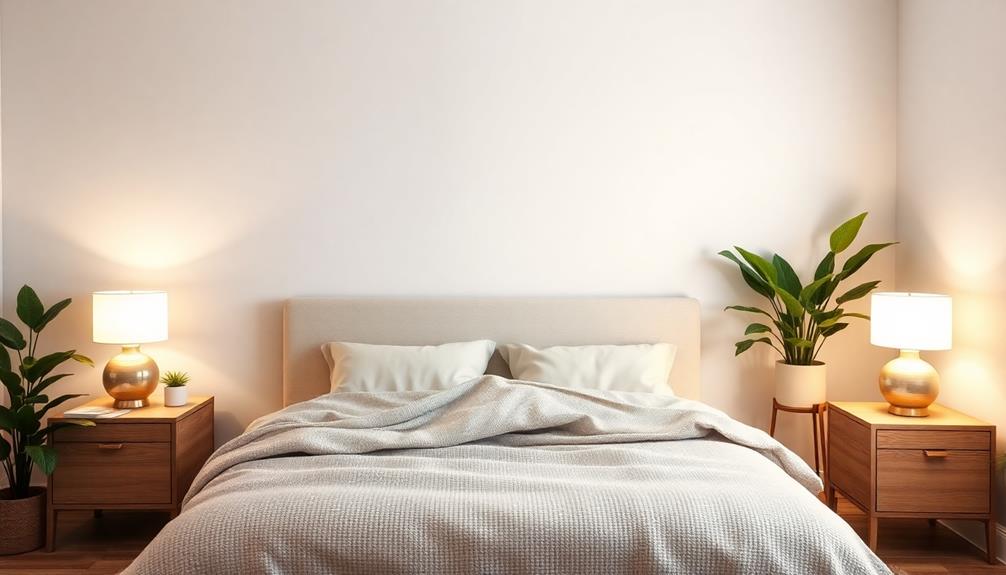
Creating a harmonious bedroom environment starts with the strategic placement of your bed. Position your bed in a commanding location, ideally against a solid wall and not directly facing the door. This arrangement enhances your feelings of security and control while you sleep.
In traditional Indonesian housing, for example, the layout often reflects spiritual elements and cultural symbolism that contribute to a sense of peace within the home, emphasizing the significance of a well-considered space for rest and rejuvenation traditional Indonesian housing.
To guarantee good feng shui, keep the space under your bed clutter-free to promote positive energy flow.
Here are some tips to optimize your bedroom arrangement:
- Choose soothing colors: Soft hues create a calming atmosphere for relaxation.
- Avoid mirrors facing the bed: They can disrupt sleep by reflecting energy and causing restlessness.
- Incorporate natural elements: Adding plants boosts vitality and well-being.
- Guarantee proper bed placement: A solid wall gives you a sense of support and stability.
- Declutter regularly: A tidy space invites peace and tranquility.
Kitchen Feng Shui Essentials

After setting up a restful bedroom, the kitchen deserves equal attention for fostering positive energy. In Feng Shui, the layout of your kitchen greatly impacts your home's overall energy flow.
Start by positioning your stove in a command position, ideally facing the entrance. This arrangement enhances your control and awareness while cooking and avoids direct confrontation with the sink, maintaining elemental harmony. For a more luxurious touch, consider integrating elements of luxury tropical designs that incorporate natural materials and vibrant colors.
Next, focus on the work triangle: the stove, sink, and refrigerator. Keeping this area balanced and unobstructed promotes efficient energy flow, making meal preparation smoother.
Verify that your dining table is centrally located and doesn't block access points, creating a welcoming environment for family gatherings.
To enhance tranquility, use natural materials and colors in your kitchen. Incorporate wooden cabinets and earth-toned accents to create a grounding atmosphere.
Regularly declutter countertops and storage areas to prevent stagnant energy. By eliminating clutter, you'll create a more inviting and functional cooking space that encourages creativity.
With these Feng Shui essentials, you'll transform your kitchen into a hub of positive energy and harmony.
Common Feng Shui Mistakes

When it comes to Feng Shui, many people unknowingly make common mistakes that can hinder the flow of positive energy in their spaces. Here are five key pitfalls to avoid:
- Overcrowding spaces with furniture creates clutter and obstructs energy flow, much like how excessive decor can detract from the beauty of Indonesian decor masks.
- Neglecting natural light leads to dark, uncomfortable environments that trap negative energy.
- Misaligning furniture with doorways blocks the welcoming energy that enters your home.
- Ignoring color choices can negatively impact your mood and the overall atmosphere.
- Failing to declutter results in stagnant energy, making your space feel chaotic.
To create a harmonious environment, focus on optimizing your furniture layout. Verify that your spaces aren't overcrowded, allowing for smooth movement and energy flow.
Pay attention to natural light; let it in to invigorate the room. Align your furniture thoughtfully with doorways and consider how colors affect your feelings and energy levels.
Regular decluttering is essential to maintaining a balanced space, as it fosters a sense of tranquility and openness.
Frequently Asked Questions
How to Arrange Furniture in Feng Shui?
To arrange furniture in Feng Shui, position larger pieces against solid walls for stability, create circular seating arrangements for connection, keep pathways clear for smooth movement, and place beds and desks facing the entrance for control.
How Do I Find the Best Furniture Layout?
To find the best furniture layout, sketch your floor plan, guarantee clear pathways, position larger pieces against walls, avoid blocking doorways, balance visual weight, and use area rugs to define conversation zones effectively.
What Is the Best Layout for Feng Shui?
When it comes to Feng Shui, you'll want to create a space that flows smoothly. Arrange furniture to encourage conversation, position your bed for security, and incorporate natural elements for a harmonious, inviting atmosphere.
How Do You Arrange Furniture for Positive Energy?
To arrange furniture for positive energy, place sofas and chairs in circular or U-shaped layouts, avoid blocking doorways, maintain clear pathways, position key pieces to face entrances, and incorporate natural elements like plants for liveliness.
Conclusion
Just like a river flows freely through a forest, your home should allow energy to move smoothly. When you embrace the principles of feng shui, you're not just arranging furniture; you're crafting a harmonious environment that nurtures your spirit. Avoid the rocks that block your path—common mistakes in placement can disrupt the flow. By thoughtfully considering each space, you're creating a sanctuary where energy thrives, much like a garden blossoming under the sun.
- About the Author
- Latest Posts
Introducing Ron, the home decor aficionado at ByRetreat, whose passion for creating beautiful and inviting spaces is at the heart of his work. With his deep knowledge of home decor and his innate sense of style, Ron brings a wealth of expertise and a keen eye for detail to the ByRetreat team.
Ron’s love for home decor goes beyond aesthetics; he understands that our surroundings play a significant role in our overall well-being and productivity. With this in mind, Ron is dedicated to transforming remote workspaces into havens of comfort, functionality, and beauty.
Southeast Asia Decor
Ultimate Guide to Harmonious Furniture Placement
Perfecting your furniture placement can elevate your space dramatically; discover essential tips that will transform your home into a stylish retreat.

Mastering harmonious furniture placement transforms your space into a sanctuary of comfort and style. Start by measuring your room and furniture accurately, ensuring you maintain clear pathways for movement. Create functional zones for activities, like conversation or dining, and aim for 18-30 inches of space between furniture pieces. Balance your layout with aesthetics, placing matching items intentionally for symmetry. Don't forget storage solutions to keep your space organized and clutter-free. Incorporate principles of Feng Shui to promote a positive energy flow throughout your home. Curious about more tips to elevate your design? There's plenty more to uncover!
Key Takeaways
- Measure room dimensions accurately and maintain clear pathways of at least three feet for optimal traffic flow.
- Establish functional zones using area rugs to create distinct spaces for conversation, dining, and media.
- Position primary furniture facing focal points while ensuring 18-30 inches of space between pieces for comfort.
- Incorporate multifunctional furniture and vertical storage solutions to reduce clutter and enhance space efficiency.
- Balance aesthetics and functionality by using a mix of textures, colors, and symmetrical arrangements for a harmonious design.
Challenges in Furniture Arrangement
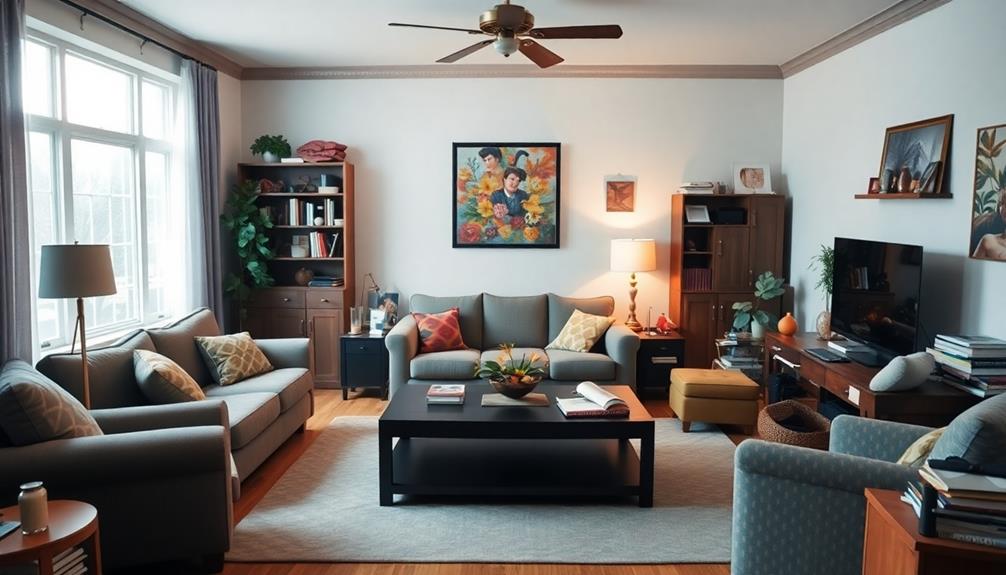
When it comes to arranging furniture, you often face a variety of challenges that can complicate your design plans. Oddly shaped spaces, particularly those created by home additions, can hinder effective use of the area, making furniture arrangement tricky. Prioritizing aesthetics over functionality may lead to obstructed pathways, disrupting the flow of movement and creating clutter.
To create a more balanced atmosphere, consider integrating natural materials and earth tones, which are hallmarks of Balinese design characteristics.
The placement of windows adds another layer of complexity, limiting your options. You'll need to find creative solutions that maintain both light and functionality while ensuring clear pathways. Rooms with multiple entry and exit points require careful attention to accessibility; you want to facilitate ease of movement without sacrificing visual appeal.
Additionally, large or narrow rooms present unique challenges. In these cases, it's crucial to enhance traffic flow and functionality without overwhelming the space. You must find a balance that allows for comfortable navigation while showcasing your design style.
Planning Your Layout

To plan your layout effectively, start by measuring your space and making a scaled drawing or using digital tools.
Incorporating elements like Indonesian Decorative Pillows can add vibrant colors and patterns, enhancing the overall aesthetic of your living area.
Visualizing how furniture flows within the room helps you establish functional zones for different activities.
This thoughtful approach guarantees your space is both accessible and harmonious.
Space Measurement Techniques
Measuring your space accurately is essential for planning an effective furniture layout. Start by measuring the length and width of each wall in your room, including windows and doors. This creates an accurate blueprint for your layout. Use graph paper or digital tools like Floorplanner to draft a scaled version, allowing you to experiment with arrangements easily.
Next, measure the dimensions of your furniture pieces to guarantee they fit comfortably within designated spaces. Remember to account for accessibility and comfort by maintaining a minimum of three feet of width for main walkways and 18-30 inches between furniture pieces.
To help you visualize your space and its functionality, consider the following table:
| Measurement Aspect | Recommended Size |
|---|---|
| Main Walkways | 3 feet minimum |
| Space Between Furniture | 18-30 inches |
| Room Dimensions (Length) | Measure each wall |
| Room Dimensions (Width) | Measure each wall |
| Furniture Dimensions | Measure all pieces |
Visualizing Furniture Flow
Visualizing furniture flow is essential for creating a functional and inviting space. By carefully planning your layout, you can guarantee a harmonious living space that promotes ease of movement and comfort.
Incorporating elements from traditional Indonesian style home decor can enhance the warmth and aesthetic appeal of your design. Here are some furniture placement tips to help you visualize the flow:
- Measure Your Room: Start by measuring your room's dimensions, including walls, windows, and doors. This will provide an accurate representation for effective planning.
- Use Design Tools: Utilize graph paper or digital tools like Floorplanner to create a scaled layout, allowing you to experiment with different arrangements.
- Map Traffic Flow: Draw paths of movement within the room, guaranteeing main walkways are at least three feet wide. This promotes smooth traffic flow and ample space for movement.
- Consider Focal Points: Place primary furniture pieces facing focal points, like a comfortable chair near a fireplace or television, maintaining 18-30 inches of spacing to create negative space.
Establishing Functional Zones
Creating distinct functional zones is a key aspect of planning your layout, allowing you to maximize the usability of your space. By designing areas for conversation, media, and dining, you guarantee each zone enhances overall functionality.
Utilizing area rugs can visually unify furniture within a zone, promoting a cohesive layout. This helps define spaces while making them aesthetically pleasing. Here's a quick reference table to guide your design:
| Functional Zone | Key Considerations |
|---|---|
| Conversation Area | 18-30 inches between pieces |
| Media Zone | 10 feet from TV for viewing |
| Dining Zone | Guarantee ample space for movement |
Maintain a minimum of three feet in width for main walkways to facilitate smooth traffic flow. Consider the scale and size of your furniture relative to room dimensions; this guarantees each area feels balanced and doesn't become overcrowded. Proper furniture placement is crucial in creating functional zones that work harmoniously, allowing your space to be both practical and inviting.
Functional Zones and Flow

To create a harmonious space, you need to define distinct activity areas that support how you use the room.
Incorporating elements from traditional Indonesian housing can inspire unique furniture arrangements that reflect cultural significance.
By enhancing movement paths, you guarantee everyone can navigate freely without obstruction.
This thoughtful arrangement not only boosts functionality but also elevates the overall flow of your home.
Defining Activity Areas
In any well-designed room, defining activity areas is essential for enhancing usability and comfort. By creating distinct functional zones, like conversation areas and media zones, you can guarantee that each space serves its purpose effectively.
For instance, incorporating elements from luxury tropical design aesthetics can elevate your living space while maintaining functionality. Here are some tips to help you achieve this:
- Establish Conversation Zones: Arrange seating to encourage interaction, keeping 18-30 inches between pieces for comfortable spacing.
- Use Area Rugs: These can visually unify your furniture within specific zones, reinforcing a cohesive design.
- Maintain Traffic Flow: Confirm main walkways are at least three feet wide to promote accessible movement and ease of navigation.
- Plan Movement Paths: Before arranging your furniture, draw out paths of travel. This helps visualize how functional zones connect, guaranteeing a smooth traffic flow throughout the room.
Enhancing Movement Paths
Movement paths play an essential role in the overall functionality of a space, ensuring that each area flows seamlessly into the next. To enhance movement paths, start by ensuring main walkways are at least three feet wide, allowing for comfortable movement and accessibility.
Incorporating elements of tropical-themed luxury design can also elevate the aesthetic while maintaining functionality. Aim for 18-30 inches of space between furniture pieces to prevent overcrowding and promote easy navigation.
When arranging your furniture, position primary seating about ten feet from the TV for ideal viewing and maintain clear pathways around it. This won't only keep traffic flow uninterrupted but also create distinct functional zones within your room.
Use area rugs to visually unify your furniture arrangements, helping to define these zones while enhancing usability.
To visualize movement, draw pathways on a floor plan before you commit to furniture placement. This will help you identify any potential blockages in traffic flow and allow adjustments for a more harmonious layout.
Aesthetic Enhancements

A well-thought-out placement of furniture and decor can dramatically elevate the aesthetic appeal of your space. Incorporating unique elements like traditional artistry through Indonesian decor masks can enhance your interior while reflecting cultural richness.
By focusing on key elements, you create a harmonious environment that invites relaxation and enjoyment. Here are some aesthetic enhancements you can incorporate:
- Rug Placement: Extend dining room rugs 36 inches past the table edges for comfort, and guarantee bedroom rugs extend at least 18 inches past the bed frame for a cohesive look.
- Artwork: Center artwork at eye level, about 57 inches from the floor, and maintain a width of 2/3 of the furniture piece beneath it to establish an enchanting focal point.
- Lighting Variety: Use a mix of overhead, task, and ambient lighting. Hang dining room fixtures 30-34 inches above the table for ideal illumination, creating an inviting atmosphere.
- Accent Colors: Introduce cushions and throws to add accent colors that complement your color scheme, while keeping 2-3 inches of negative space between art pieces for a sense of order.
Storage and Decluttering
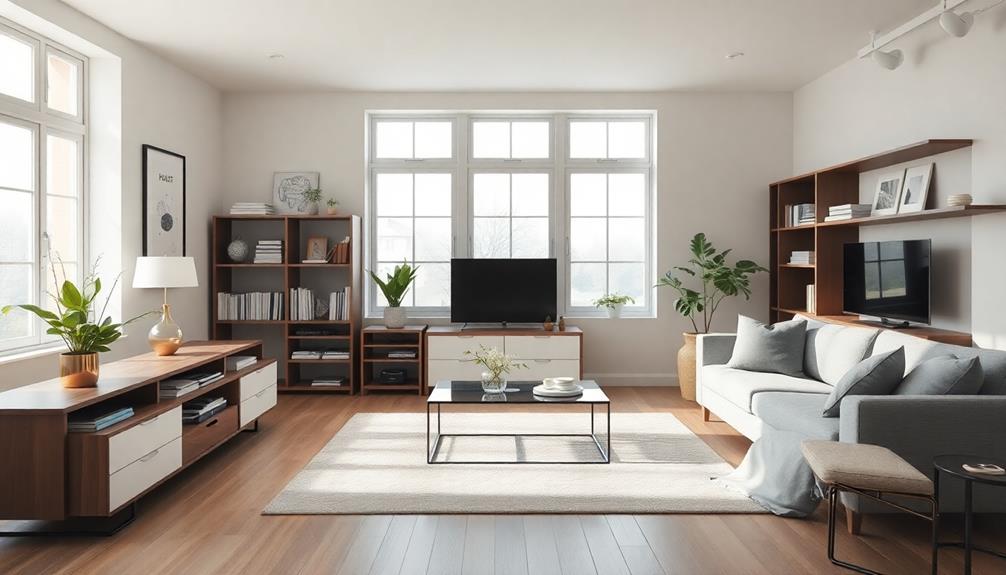
Creating a visually appealing space goes hand in hand with effective storage solutions. To achieve this balance, prioritize multifunctional furniture, like ottomans with storage or coffee tables with drawers. These pieces not only reduce clutter but also maximize space efficiency.
Utilizing vertical storage solutions, such as wall-mounted shelves and over-the-door organizers, keeps items off the floor and fosters an open environment. Regularly reassess your belongings and adopt a decluttering system, like the "one in, one out" rule, to maintain an organized space.
Organizing items by category in designated storage spaces, like baskets or bins, enhances functionality and streamlines the decluttering process. Additionally, consider incorporating built-in storage options, such as under-bed drawers or closet organizers, to optimize storage and guarantee items are easily accessible while promoting visual harmony.
| Storage Solutions | Benefits |
|---|---|
| Multifunctional Furniture | Reduces clutter |
| Vertical Storage | Creates open environment |
| Decluttering System | Maintains organized space |
| Built-in Storage | Optimizes storage |
Principles of Feng Shui

When arranging your furniture, understanding the principles of Feng Shui can greatly enhance the energy flow in your space. By applying these principles, you can create a balanced space that fosters a cozy atmosphere and promotes harmonious living.
Here are some key elements to bear in mind:
1. Clutter Avoidance: Keep your space tidy. Clutter disrupts energy flow, so regularly assess your belongings to maintain a clear environment.
Think about using Indonesian wedding decor ideas that promote minimalism and elegance in your living space.
2. Optimal Placement: Position your furniture to allow for clear pathways. This guarantees smooth circulation of energy (Qi) and creates a welcoming vibe.
3. Yin and Yang Balance: Reflect on the balance between calm (Yin) and vibrant (Yang) energies. A mix of soft textures and lively colors can help achieve tranquility.
4. Elemental Colors: Incorporate colors associated with the five elements: earth, metal, water, wood, and fire.
This not only enhances the aesthetic but also supports the energy needs of your space.
Achieving Balance and Symmetry

Achieving balance and symmetry in your furniture placement can transform a room from chaotic to serene. When you guarantee that visual weight is evenly distributed, you create a harmonious space that feels cohesive and inviting.
To achieve symmetry, position identical pieces, like sofas or chairs, on opposite sides of a central focal point. This arrangement fosters order and stability, making your space more visually appealing.
Incorporating elements inspired by modern tropical aesthetics in Bali can further enhance the natural flow of your space. Don't forget the accessories! Using matching items, like lamps or artwork, on either side of your focal point enhances the symmetrical layout and adds to the overall aesthetic.
While symmetrical arrangements provide a sense of calm, you can also experiment with asymmetrical arrangements for a dynamic atmosphere. Just remember to maintain balance by strategically placing contrasting elements throughout the room.
Properly balancing larger furniture pieces, such as spreading heavier items across different areas, encourages movement and interaction. This thoughtful placement helps maintain a visually appealing environment.
Frequently Asked Questions
How Can I Incorporate Plants Into My Furniture Arrangement?
You can easily incorporate plants into your furniture arrangement by placing them on shelves, beside seating areas, or hanging them near windows. This adds life, color, and improves the overall ambiance of your space.
What Colors Work Best for a Harmonious Space?
What colors make you feel most at ease? Soft neutrals, calming blues, and gentle greens create a harmonious space. They promote relaxation and balance, making your environment inviting and serene. Don't underestimate the power of color!
How Do I Choose the Right Furniture Size for My Room?
To choose the right furniture size for your room, measure your space first. Consider the room's layout, leaving enough walking space, and guarantee the furniture complements your style without overwhelming the area.
What Are Some Tips for Arranging Furniture in Small Spaces?
When arranging furniture in small spaces, focus on multifunctional pieces, keep pathways clear, and utilize vertical storage. Position larger items against walls, and use mirrors to create an illusion of more space.
How Do I Maintain Harmony With Changing Seasons or Trends?
As leaves shift colors, you can refresh your space by swapping textiles and decor that reflect the season. Embrace warm tones in autumn, and lighten up with bright accents during spring—keeping your environment vibrant and harmonious.
Conclusion
Now that you've explored the ins and outs of harmonious furniture placement, you're ready to transform your space like a master chef whipping up a gourmet dish. Remember to take into account flow, functionality, and aesthetics as you arrange your furniture. Embrace balance and declutter to create a serene environment that feels just right. With these tips, your home will not only look good but also feel like a warm hug, inviting you to unwind and enjoy every moment.
- About the Author
- Latest Posts
Introducing Ron, the home decor aficionado at ByRetreat, whose passion for creating beautiful and inviting spaces is at the heart of his work. With his deep knowledge of home decor and his innate sense of style, Ron brings a wealth of expertise and a keen eye for detail to the ByRetreat team.
Ron’s love for home decor goes beyond aesthetics; he understands that our surroundings play a significant role in our overall well-being and productivity. With this in mind, Ron is dedicated to transforming remote workspaces into havens of comfort, functionality, and beauty.
Southeast Asia Decor
Feng Shui Furniture Tips for Local Interiors
With these essential Feng Shui furniture tips, transform your local interiors into a harmonious sanctuary that invites peace and joy—discover how to begin today!

To enhance your local interiors using Feng Shui, start by arranging furniture to encourage conversation and flow. Position your couch and chairs facing each other for connection, and place your bed against a solid wall for security. Introduce natural elements like indoor plants and water features to invite tranquility. Keep pathways clear and declutter regularly to boost positive energy. Choose calming colors and incorporate personal items that evoke joy. By balancing heavy and light elements, you create visual harmony. There's plenty more to explore for a truly balanced space that reflects your unique style.
Key Takeaways
- Position sofas and chairs to face each other, fostering conversation and connection among occupants in your local interior space.
- Utilize the Bagua map to align furniture with different areas of life, enhancing specific energies in your home.
- Ensure clear pathways by avoiding large furniture blocking entrances, allowing smooth energy circulation throughout the space.
- Incorporate natural materials and calming colors to create a grounding and tranquil environment reflective of local aesthetics.
- Add indoor plants to purify air and reduce stress, enhancing the overall well-being of your living space.
Principles of Feng Shui
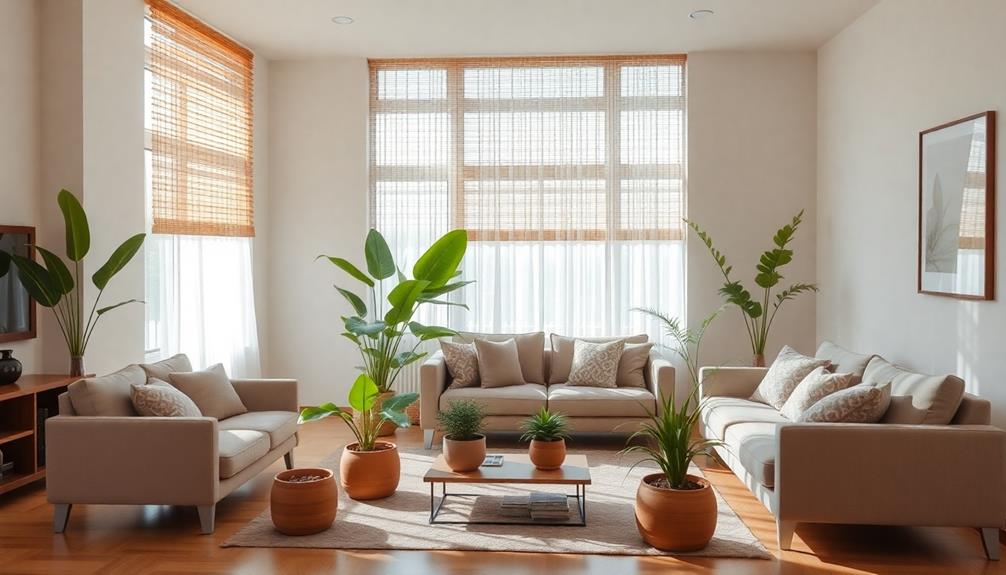
Feng Shui, rooted in ancient Chinese philosophy, focuses on how you arrange your space to enhance the flow of energy, or Chi. Understanding the principles of Feng Shui is vital to create a harmonious environment.
Start by recognizing the five elements: earth, metal, water, wood, and fire. Each of these elements has specific qualities, colors, and shapes that, when integrated correctly, promote balance and energy flow throughout your home. Additionally, incorporating elements of Balinese design characteristics can enrich your space and create a deeper connection to nature.
Balance between Yin and Yang energies is also essential. You want to make certain that your space reflects both active and passive elements, fostering tranquility and equilibrium. Each room has unique energy requirements, so pay attention to how you can facilitate positive interactions through thoughtful placements and decor.
Incorporating natural elements, like plants or water features, can greatly enhance your space. Decluttering is another key aspect; a tidy environment boosts your energy flow throughout the home.
Keep these Feng Shui tips in mind as you explore how to create a balanced atmosphere, making your living space a sanctuary that promotes well-being and peace.
Furniture Arrangement Techniques
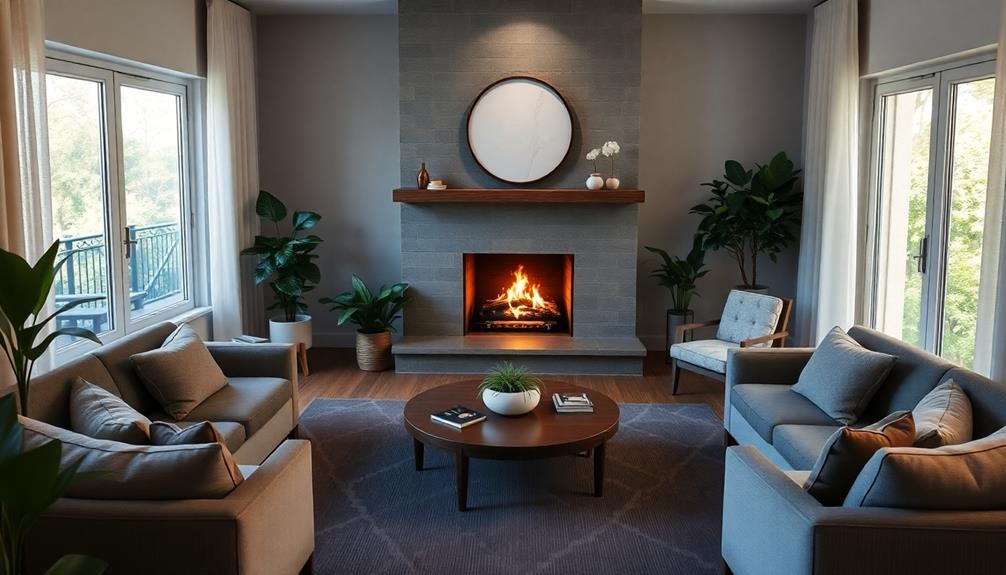
Creating a harmonious environment goes beyond understanding the principles of Feng Shui; it involves practical applications like furniture arrangement techniques that enhance the flow of Chi in your space.
Incorporating elements of Indonesian Decorative Pillows adds vibrant colors and intricate patterns that can further improve the energy and comfort of your living areas. Proper furniture arrangement promotes ideal energy flow, creating an open and inviting atmosphere while avoiding clutter that disrupts Chi.
To make the most of your space, consider these essential tips:
- Position couches and chairs facing each other in living rooms to spark conversation and connection.
- Place your bed against a solid wall opposite the door in bedrooms for a sense of security and relaxation.
- In home offices, make sure your desk faces the entrance with a solid wall behind to foster control and awareness.
- Keep pathways clear and avoid blocking entrances with large furniture pieces to maintain smooth energy circulation.
Enhancing Living Space Harmony

Enhancing the harmony of your living space involves mindful choices that resonate with your personal energy. Start by arranging your living room furniture to encourage conversation; position couches and chairs facing each other to promote connection among occupants.
Consider incorporating elements of traditional Indonesian style home decor, such as intricate carvings or natural materials, to bring an authentic touch to the ambiance. Use the Bagua map to align your furniture placement with specific life areas, ensuring each quadrant resonates with its intended energy. For instance, incorporate wood accents in the wealth area to amplify abundance.
Clearing clutter around the entrance and throughout your home is essential, as it facilitates a smooth flow of energy (Chi), creating a serene atmosphere. Incorporating natural elements, like plants and wooden decor, helps ground the space, fostering tranquility and positively impacting the energy dynamics within your living area.
Pay attention to lighting to enhance harmony. Use multiple indirect sources, such as table lamps, to create a warm and inviting ambiance.
This thoughtful approach to Feng Shui in your furniture arrangement can considerably elevate the energy of your living space, making it a more welcoming and balanced environment. By integrating these strategies, you'll cultivate a harmonious atmosphere that reflects your personal style and promotes positive interactions.
Promoting Well-Being Through Design

Well-designed spaces can significantly impact your well-being, making you feel more at ease in your environment. By focusing on furniture placement, you can enhance positive energy flow and create harmony in your home.
For instance, incorporating elements from luxury tropical design aesthetics can create a serene atmosphere that nurtures relaxation. Here are a few key strategies to contemplate:
- Arrange furniture to promote open pathways, allowing for clear movement and reducing clutter.
- Use the Bagua map to align your furniture with specific life areas, attracting positive energy that enhances wealth, relationships, and health.
- Select colors based on Feng Shui principles; calming blues and greens can create relaxation, while vibrant reds energize your space.
- Regularly declutter and organize your furniture to nurture a harmonious atmosphere that supports emotional well-being.
Incorporating Natural Elements

Incorporating natural elements into your home not only boosts the aesthetic appeal but also aligns with Feng Shui principles, promoting a harmonious flow of positive energy (Chi). By integrating features like indoor plants, wooden furniture, and water elements, you can greatly enhance your living space.
Consider placing wooden decor in the south area of your home to ignite creativity and liveliness. Indoor plants are excellent for purifying the air and connecting you to nature, helping reduce stress. Additionally, introducing water features like small fountains in the north section can attract career luck and prosperity.
Here's a quick reference table to help you visualize these ideas:
'''markdown
| Natural Element | Feng Shui Area |
|---|---|
| Indoor Plants | Any area |
| Wooden Furniture | South |
| Water Features | North |
| Natural Materials | Living Spaces |
'''
Embracing these natural elements not only cultivates a tranquil environment but also balances the five elements, creating a sense of stability and comfort. By doing so, you'll experience an uplifting flow of energy throughout your home.
Personalizing Your Space

Personalizing your space transforms it into a sanctuary that reflects your unique identity. By incorporating meaningful items, you enhance the positive energy flow, creating a comforting environment that resonates with who you are.
Think about adding vibrant traditional artistry through Indonesian decor masks that can serve as focal points in your home. Here are some ideas to reflect on:
- Display family photos that evoke happy memories.
- Include sentimental objects that tell your story.
- Use nature elements like plants or stones to foster tranquility.
- Choose colors and materials that reflect your personal style.
When you choose decor that speaks to you, your space becomes a true extension of yourself. Unique decor items and textures not only add depth but also guarantee your home aligns with Feng Shui principles.
Regularly rotating your decor with the seasons keeps your environment feeling fresh and maintains balanced energy. Thoughtfully curated items that resonate with positive memories serve as anchors for good energy, reinforcing a nurturing atmosphere.
Embrace the process of personalizing your space, and you'll find that it becomes a haven filled with positive energy, inviting warmth, and genuine comfort. Your home will truly embody your essence, making it a place where you love to be.
Frequently Asked Questions
How to Place Furniture According to Feng Shui?
To place furniture according to Feng Shui, arrange larger pieces to encourage conversation, guarantee beds are against solid walls, position desks facing doors, and keep pathways clear. Incorporate natural elements for balance and tranquility.
What Are the Feng Shui Rules for Couches?
When positioning your couch, face it toward the entrance for a welcoming vibe. Avoid placing it against the door, keep space around it clear, and opt for soft colors and rounded edges to enhance comfort.
Should Sofa Be Against the Wall Feng Shui?
You shouldn't always place your sofa against the wall. While it offers stability, positioning it to face the door enhances energy flow and creates a welcoming atmosphere, promoting relaxation and social interaction in your space.
How to Decorate Your Home According to Feng Shui?
Did you know that 90% of people feel calmer in organized spaces? To decorate your home according to Feng Shui, use the Bagua map, incorporate the five elements, and prioritize decluttering for positive energy flow.
Conclusion
By weaving these feng shui principles into your home, you're not just arranging furniture; you're orchestrating a symphony of balance and tranquility. Each piece can become a brushstroke on the canvas of your life, inviting harmony and well-being to flourish. As you embrace natural elements and personalize your space, you create a sanctuary that breathes with energy and intention. So go ahead, transform your interiors into a vibrant reflection of your inner peace, and let your home tell your story.
- About the Author
- Latest Posts
Introducing Ron, the home decor aficionado at ByRetreat, whose passion for creating beautiful and inviting spaces is at the heart of his work. With his deep knowledge of home decor and his innate sense of style, Ron brings a wealth of expertise and a keen eye for detail to the ByRetreat team.
Ron’s love for home decor goes beyond aesthetics; he understands that our surroundings play a significant role in our overall well-being and productivity. With this in mind, Ron is dedicated to transforming remote workspaces into havens of comfort, functionality, and beauty.
-

 Retreat3 weeks ago
Retreat3 weeks agoThe Pros and Cons of Different Retreat Center Business Models
-
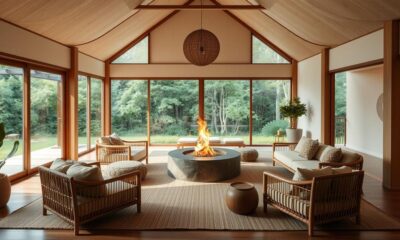
 Retreat4 weeks ago
Retreat4 weeks ago10 Unique Themed Room Ideas for Your Retreat Center
-

 Retreat4 weeks ago
Retreat4 weeks agoThe Business of Retreats: Marketing Strategies for Success
-

 Southeast Asia Decor4 weeks ago
Southeast Asia Decor4 weeks agoIndonesian Textiles Shaping Contemporary Interior Design
-
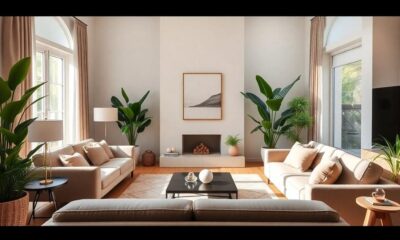
 Southeast Asia Decor3 weeks ago
Southeast Asia Decor3 weeks ago10 Tips for Feng Shui in Local Interiors
-

 Retreat4 weeks ago
Retreat4 weeks agoCreating a Meditation Room in Your Home: Tips and Ideas
-
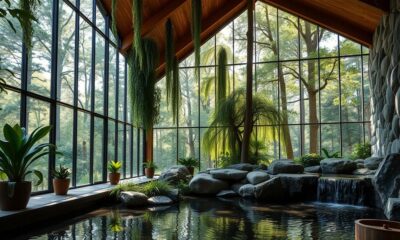
 Retreat6 days ago
Retreat6 days agoIncorporating Biophilic Design in Your Retreat Center
-
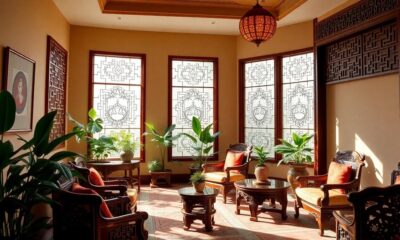
 Southeast Asia Decor2 weeks ago
Southeast Asia Decor2 weeks agoHistorical Feng Shui Color Schemes in Interiors









